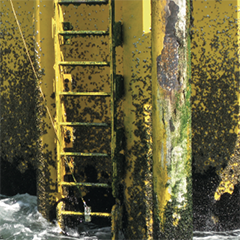Over the years, Jo van Montfort, from Bjond b.v.b.a. has convinced PES that the wind industry needs to look beyond standards and protocols to reduce the maintenance costs of turbines. It seems incredible that companies don’t seem to realise that they are not getting the best out of their coatings, despite what the tests say.
Definition
The best definition of a protective coating system is: ‘Transparent or coloured product that forms a film and protects the surface on which it is applied against influences from the environment.’ This means a barrier is created between the steel and environment in order to prevent corrosion.
This barrier is applied as a liquid material that adheres to the steel substrate and forms an oxygen, chemicals (‘salts’) and water or moisture proof film. In most cases, this film is less than 1mm thick and more than 300μm. In many cases this thin film needs to protect the steel for more than 20 years, preferably maintenance free.
Type of failures
The main failure of a coating system when properly applied is losing its main barrier function. This means the coating cracks. When the cracks grow through the coating oxygen, water and chemicals (‘salts’) can reach the steel substrate, resulting in corrosion.
There are three stages of cracking:
1.
Micro-cracking (superficial cracks up to the upper 100 μm)
2.
Meso-cracking (cracks reaching up to the top of the primer layer)
3.
Macro-cracking (cracks reaching up to the steel substrate)
Over time a coating system will degrade depending on where it is being used. For example, from UV-(sun)light, thermal shocks, water etc. The coating will start to crack and finally fail. There are different types of methods available to control this, such as EIS (electrochemical Impedance Spectroscopy) but a very reliable one is microscopical analysis of cross sections.
It is clear that serious problems occur when the coating system shows cracks shortly after application. This is especially true of coating materials that show a high degree of internal shrinkage after application. These coatings exhibit significantly lower tolerance to application conditions and can easily crack and delaminate at the edges, welds and locations where the film thickness is higher than allowed.
Surface preparation
‘If you fail to prepare, you prepare to fail’* is a well-known statement in the protective coating business. Based on this some claim that more than 70-80% of all premature coating failures are due to bad or insufficient surface preparation. According to our experience and damage analyses in Germany Lit.1), it can be concluded that inadequate processing and/or incorrect application causes between 43% and 68% of the premature coating failures, such as:



























